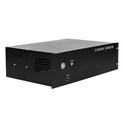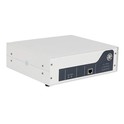Hey there! As a supplier of the ResoLab - 1000 Lab Grade Ultrasonicator, I often get asked if this nifty piece of equipment can be used for cell disruption. Well, let's dive right into it and find out!
First off, what's cell disruption? In simple terms, it's the process of breaking open cells to release their contents, like proteins, DNA, and other biomolecules. Scientists use this technique in a whole bunch of research areas, such as drug discovery, genomics, and proteomics.


Now, let's talk about the ResoLab - 1000 Lab Grade Ultrasonicator. Ultrasonication is a popular method for cell disruption, and this machine is designed to generate high - frequency sound waves. These sound waves create something called cavitation in the liquid medium where the cells are suspended. Cavitation is the formation, growth, and sudden collapse of tiny bubbles in the liquid. When these bubbles collapse, they produce a ton of energy in the form of shockwaves. These shockwaves are strong enough to break the cell membranes, effectively disrupting the cells.
The ResoLab - 1000 comes with a bunch of features that make it suitable for cell disruption. It has adjustable power settings. This is super important because different types of cells require different levels of energy to be disrupted. For example, bacterial cells are generally tougher to break compared to mammalian cells. With the adjustable power on the ResoLab - 1000, you can dial in the right amount of energy for your specific cell type.
Another great feature is the pulse mode. In cell disruption, continuous exposure to ultrasound can generate a lot of heat, which might damage the biomolecules you're trying to extract. The pulse mode on the ResoLab - 1000 allows you to alternate between periods of ultrasound and rest. This helps to keep the temperature under control and protects the integrity of the cell contents.
Let's take a look at some real - world applications. In a recent study, researchers were trying to extract proteins from yeast cells. They used the ResoLab - 1000 and found that it was very effective in disrupting the yeast cells. By adjusting the power and using the pulse mode, they were able to achieve a high yield of proteins without significant degradation.
But it's not just about yeast cells. The ResoLab - 1000 can also be used for disrupting other types of cells, like plant cells. Plant cells have a tough cell wall, but the cavitation effect created by the ultrasonicator can break through this barrier. Of course, you might need to adjust the settings a bit more compared to mammalian or bacterial cells, but it's definitely doable.
Now, I know some of you might be thinking, "Well, what if I need something more powerful or less powerful?" That's where our other products come in. If you need a more powerful option, check out the ResoLab - 2000 Lab Grade Ultrasonicator. It's designed for larger - scale cell disruption and can handle more volume. On the other hand, if you're working with smaller samples, the ResoLab - 500 Lab Grade Ultrasonicator might be a better fit.
However, there are a few things to keep in mind when using the ResoLab - 1000 for cell disruption. First, make sure you're using the right probe. The probe is the part of the ultrasonicator that actually delivers the ultrasound to the sample. Different probes have different diameters and are suitable for different sample volumes.
Second, always follow the safety guidelines. Ultrasonic waves can be harmful if you're directly exposed to them. So, make sure to wear appropriate protective gear and operate the machine in a well - ventilated area.
In conclusion, the ResoLab - 1000 Lab Grade Ultrasonicator is definitely a great option for cell disruption. Its adjustable power, pulse mode, and other features make it versatile and effective. Whether you're a researcher in a small lab or a scientist in a large - scale biotech company, this machine can help you get the job done.
If you're interested in learning more about how the ResoLab - 1000 can fit into your cell disruption needs, or if you want to discuss purchasing options, don't hesitate to reach out. We're here to help you make the best choice for your research.
References
- "Ultrasonication for Cell Disruption: Principles and Applications" - Journal of Biotech Research
- "Comparative Study of Different Ultrasonication Methods for Cell Disruption" - Biotech Science Review





